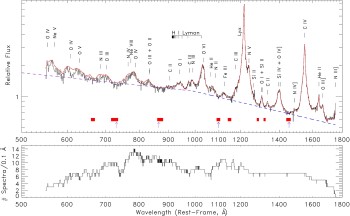 |
TitleCosmic Origins Spectrograph Average Spectrum of 22 AGNs (Active Galactic Nuclei)
DescriptionThe spectra were shifted to appear as if they were not redshifted before being averaged. All the objects have spectra that look like quasi-stellar objects, but some are of low enough luminosity that the host galaxy is visible and has a name. The main features of the spectrum are as follows: a purple/blue line drawn through the spectrum is the "continuum," mostly due to the AGN, a continuous glow caused by a very hot gas in a strong magnetic field; a red line represents the fitted spectrum of emission lines, thought to arise in a disk that surrounds the central black hole of the AGN. (These are most clear at the right end.) The ions that are seen in emission are labelled: N V, C IV, He II etc. The Roman numeral is the charge of the ion plus one: N V is four-times ionized oxygen, meaning that four electrons have been stripped off the atom. The ion has a net charge of positive four. The black line traces the actual data. Below about 950 Å, neutral hydrogen absorption lines from the intergalactic medium exist in each of the individual spectra, which had to removed as best as possible before averaging. The red rectangles at the bottom denote regions between the AGN emission lines that are taken to represent the continuum emission of the AGN. The resolution is about 20,000 km/sec. For more information about this spectrum, see Shull, J. M., Stevans, M., Danforth, C. W. 2012, ApJ, 752, 162.
FacilityHubble Space Telescope
InstrumentCosmic Origins Spectrograph (COS)
Subject- Active Galactic Nuclei
- Galaxy
Spectral TypeUltraviolet
CreditsSpectrum courtesy Michael Shull. Reproduced by permission of the AAS.
TypeObservation
Associated LessonUltraviolet Science
|